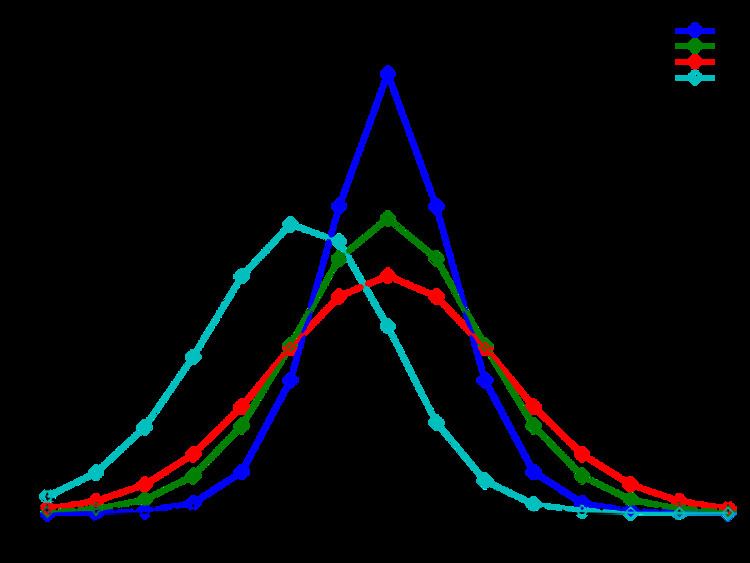Median N/A | ||
 | ||
Parameters μ 1 ≥ 0 , μ 2 ≥ 0 {\displaystyle \mu _{1}\geq 0,~~\mu _{2}\geq 0} Support { … , − 2 , − 1 , 0 , 1 , 2 , … } {\displaystyle \{\ldots ,-2,-1,0,1,2,\ldots \}} pmf e − ( μ 1 + μ 2 ) ( μ 1 μ 2 ) k / 2 I k ( 2 μ 1 μ 2 ) {\displaystyle e^{-(\mu _{1}\!+\!\mu _{2})}\left({\frac {\mu _{1}}{\mu _{2}}}\right)^{k/2}\!\!I_{k}(2{\sqrt {\mu _{1}\mu _{2}}})} Mean μ 1 − μ 2 {\displaystyle \mu _{1}-\mu _{2}\,} Variance μ 1 + μ 2 {\displaystyle \mu _{1}+\mu _{2}\,} | ||
The Skellam distribution is the discrete probability distribution of the difference
Contents
The distribution is also applicable to a special case of the difference of dependent Poisson random variables, but just the obvious case where the two variables have a common additive random contribution which is cancelled by the differencing: see Karlis & Ntzoufras (2003) for details and an application.
The probability mass function for the Skellam distribution for a difference
where Ik(z) is the modified Bessel function of the first kind. Since k is an integer we have that Ik(z)=I|k|(z).
Derivation
Note that the probability mass function of a Poisson-distributed random variable with mean μ is given by
for
Since the Poisson distribution is zero for negative values of the count
so that:
where I k(z) is the modified Bessel function of the first kind. The special case for
Note also that, using the limiting values of the modified Bessel function for small arguments, we can recover the Poisson distribution as a special case of the Skellam distribution for
Properties
As it is a discrete probability function, the Skellam probability mass function is normalized:
We know that the probability generating function (pgf) for a Poisson distribution is:
It follows that the pgf,
Notice that the form of the probability generating function implies that the distribution of the sums or the differences of any number of independent Skellam-distributed variables are again Skellam-distributed. It is sometimes claimed that any linear combination of two Skellam-distributed variables are again Skellam-distributed, but this is clearly not true since any multiplier other than
The moment-generating function is given by:
which yields the raw moments mk . Define:
Then the raw moments mk are
The central moments M k are
The mean, variance, skewness, and kurtosis excess are respectively:
The cumulant-generating function is given by:
which yields the cumulants:
For the special case when μ1 = μ2, an asymptotic expansion of the modified Bessel function of the first kind yields for large μ:
(Abramowitz & Stegun 1972, p. 377). Also, for this special case, when k is also large, and of order of the square root of 2μ, the distribution tends to a normal distribution:
These special results can easily be extended to the more general case of different means.
The following recurrence relation holds. Let
where
Bounds on weight above zero
If
Details can be found in Poisson distribution#Poisson Races
